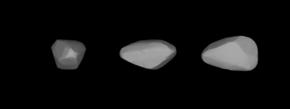4606 Saheki
 Lightcurve-based 3D-model of Saheki | |
| Discovery [1] | |
|---|---|
| Discovered by | T. Seki |
| Discovery site | Geisei Obs. |
| Discovery date | 27 October 1987 |
| Designations | |
| (4606) Saheki | |
Named after | Tsuneo Saheki (astronomer)[2] |
| 1987 UM1 · 1972 GA1 1977 TJ7 · 1977 VF2 1982 FH4 | |
| main-belt · Flora [3] | |
| Orbital characteristics [1] | |
| Epoch 4 September 2017 (JD 2458000.5) | |
| Uncertainty parameter 0 | |
| Observation arc | 63.81 yr (23,305 days) |
| Aphelion | 2.4805 AU |
| Perihelion | 2.0231 AU |
| 2.2518 AU | |
| Eccentricity | 0.1016 |
| 3.38 yr (1,234 days) | |
| 202.74° | |
| 0° 17m 30.12s / day | |
| Inclination | 2.6338° |
| 241.26° | |
| 251.92° | |
| Physical characteristics | |
| Dimensions | 6.655±0.069[4] 6.712±0.041 km[5] 7.14 km (calculated)[3] |
| 4.969±0.003 h[a] 4.97347±0.00005 h[6] 5.032±0.001 h[7] | |
| 0.24 (assumed)[3] 0.3266±0.0245[5] 0.332±0.088[4] | |
| S [3] | |
| 12.7[5] · 13.0[1][3] · 13.35±0.32[8] | |
4606 Saheki, provisional designation 1987 UM1, is a stony Flora asteroid from the inner regions of the asteroid belt, approximately 7 kilometers in diameter.
The asteroid was discovered on 27 October 1987, by Japanese astronomer Tsutomu Seki at Geisei Observatory, Japan.[9] It was later named after Japanese astronomer Tsuneo Saheki.[2]
Classification and orbit[edit]
Saheki is a member of the Flora family, one of the largest families of stony asteroids. It orbits the Sun in the inner main-belt at a distance of 2.0–2.5 AU once every 3 years and 5 months (1,234 days). Its orbit has an eccentricity of 0.10 and an inclination of 3° with respect to the ecliptic.[1] The first precovery was taken at Palomar Observatory in 1953, extending the asteroid's observation arc by 34 years prior to its discovery.[9]
Physical characteristics[edit]
Rotation period[edit]
In January 2009, a rotational lightcurve of Saheki was obtained from photometric observations by David Higgins at Hunters Hill Observatory, Australia. Lightcurve analysis rendered a well-defined rotation period of 4.969 hours with a brightness variation of 0.56 in magnitude (U=3).[a]
Two months later, in March 2009, a second lightcurve was obtained at the Via Capote Observatory (G69), California. It gave a period of 5.032 and an amplitude of 0.68 in magnitude (U=3-).[7]
Spin axis[edit]
In 2013, an international study modeled a lightcurve with a concurring period of 4.97347 hours and found a spin axis of (44.0°, 59.0°) and (222.0°, 68.0°) in ecliptic coordinates (λ, β), respectively (Q=2).[6]
Diameter and albedo[edit]
According to the survey carried out by the NEOWISE mission of NASA's Wide-field Infrared Survey Explorer, Saheki has a high albedo of 0.33 and a diameter of 6.7 kilometers,[4][5] while the Collaborative Asteroid Lightcurve Link calculates a diameter of 7.1 kilometers, based on an assumed albedo of 0.24, derived from 8 Flora, the Flora family's namesake and largest member.[3]
Naming[edit]
This minor planet was named after Japanese astronomer and president of the Toa Astronomical Society, Tsuneo Saheki (1916–1996). Over half a century, Saheki as gathered large inventory of observational data of the planet Mars.[2] The Martian crater Saheki is also named in his honour. The official naming citation was published by the Minor Planet Center on 28 May 1991 (M.P.C. 18308).[10]
Notes[edit]
- ^ a b Higgins (2011) web: rotation period 4.969±0.003 hours with a brightness amplitude of 0.56 mag. The Collaborative Asteroid Lightcurve Link assigns a quality code of U=3 to the period solution, which denotes a secure result within the precision given and no ambiguity. Summary figures for (4606) Saheki at Collaborative Asteroid Lightcurve Link (CALL)
References[edit]
- ^ a b c d "JPL Small-Body Database Browser: 4606 Saheki (1987 UM1)" (2017-06-06 last obs.). Jet Propulsion Laboratory. Retrieved 20 June 2017.
- ^ a b c Schmadel, Lutz D. (2007). "(4606) Saheki". Dictionary of Minor Planet Names – (4606) Saheki. Springer Berlin Heidelberg. p. 396. doi:10.1007/978-3-540-29925-7_4531. ISBN 978-3-540-00238-3.
- ^ a b c d e f "LCDB Data for (4606) Saheki". Asteroid Lightcurve Database (LCDB). Retrieved 23 January 2016.
- ^ a b c Masiero, Joseph R.; Mainzer, A. K.; Grav, T.; Bauer, J. M.; Cutri, R. M.; Dailey, J.; et al. (November 2011). "Main Belt Asteroids with WISE/NEOWISE. I. Preliminary Albedos and Diameters". The Astrophysical Journal. 741 (2): 20. arXiv:1109.4096. Bibcode:2011ApJ...741...68M. doi:10.1088/0004-637X/741/2/68. Retrieved 5 December 2016.
- ^ a b c d Mainzer, A.; Grav, T.; Masiero, J.; Hand, E.; Bauer, J.; Tholen, D.; et al. (November 2011). "NEOWISE Studies of Spectrophotometrically Classified Asteroids: Preliminary Results". The Astrophysical Journal. 741 (2): 25. arXiv:1109.6407. Bibcode:2011ApJ...741...90M. doi:10.1088/0004-637X/741/2/90. Retrieved 23 January 2016.
- ^ a b Hanus, J.; Broz, M.; Durech, J.; Warner, B. D.; Brinsfield, J.; Durkee, R.; et al. (November 2013). "An anisotropic distribution of spin vectors in asteroid families". Astronomy and Astrophysics. 559: 19. arXiv:1309.4296. Bibcode:2013A&A...559A.134H. doi:10.1051/0004-6361/201321993. Retrieved 23 January 2016.
- ^ a b Brinsfield, James W. (July 2009). "Asteroid Lightcurve Analysis at the Via Capote Observatory: 2009 1st Quarter". The Minor Planet Bulletin. 36 (3): 127–128. Bibcode:2009MPBu...36..127B. ISSN 1052-8091. Retrieved 23 January 2016.
- ^ Veres, Peter; Jedicke, Robert; Fitzsimmons, Alan; Denneau, Larry; Granvik, Mikael; Bolin, Bryce; et al. (November 2015). "Absolute magnitudes and slope parameters for 250,000 asteroids observed by Pan-STARRS PS1 - Preliminary results". Icarus. 261: 34–47. arXiv:1506.00762. Bibcode:2015Icar..261...34V. doi:10.1016/j.icarus.2015.08.007. Retrieved 26 April 2016.
- ^ a b "4606 Saheki (1987 UM1)". Minor Planet Center. Retrieved 23 January 2016.
- ^ "MPC/MPO/MPS Archive". Minor Planet Center. Retrieved 17 May 2016.
External links[edit]
- Asteroid Lightcurve Database (LCDB), query form (info Archived 16 December 2017 at the Wayback Machine)
- Dictionary of Minor Planet Names, Google books
- Asteroids and comets rotation curves, CdR – Observatoire de Genève, Raoul Behrend
- Discovery Circumstances: Numbered Minor Planets (1)-(5000) – Minor Planet Center
- 4606 Saheki at AstDyS-2, Asteroids—Dynamic Site
- 4606 Saheki at the JPL Small-Body Database
